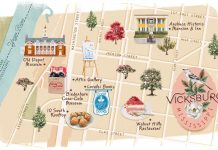
Photography by Iain Bagwell
Many a pone of cornbread has been baked to crispy perfection in a Lodge Cast Iron skillet over the past 126 years. Lauded for its longevity, the cookware has roots that trace back to a small, family-owned business (originally called Blacklock Foundry) in South Pittsburg, Tennessee. After a fire burned the first foundry to the ground in 1910, Lodge Cast Iron rose from the ashes and has remained a stalwart producer of the kitchen essential ever since.
• Open since 1896, Lodge Cast Iron is the country’s oldest cast-iron cookware company and is run by the Lodge family to this day.
• Lodge’s cast-iron pans are created by heating a blend of crude iron and other metals to a blazing 2,800 degrees, then pouring the molten metal into a mold.
• At 18 feet tall and 14,360 pounds, the world’s largest cast-iron skillet can be found at the new Lodge Museum of Cast Iron in South Pittsburg, where visitors can observe the casting process and learn about the skillet’s role in Southern food culture.
• Celebrate the skillet, along with its most famous dish, at the National Cornbread Festival in Lodge’s hometown every April. Enjoy cooking demos, carnival rides, and of course, loads of buttery cornbread.
• To keep workers employed and doors open during the Great Depression, Lodge expanded its operation to include hand-painted garden gnomes and other novelty items alongside its line of skillets.
• Lodge’s most popular products are the 10.25-inch and 12-inch classic skillets, but collectors may opt for its quirkier offerings, such as a pan in the shape of a mini guitar or one stamped with the iconic image of Rosie the Riveter.
________________________________________________________
This article appears in the Fall/Winter 2022 issue of Southbound.















